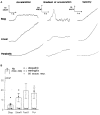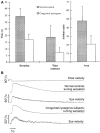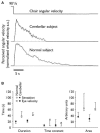Vestibular and Multi-Sensory Influences Upon Self-Motion Perception and the Consequences for Human Behavior
- PMID: 30899238
- PMCID: PMC6416181
- DOI: 10.3389/fneur.2019.00063
Vestibular and Multi-Sensory Influences Upon Self-Motion Perception and the Consequences for Human Behavior
Abstract
In this manuscript, we comprehensively review both the human and animal literature regarding vestibular and multi-sensory contributions to self-motion perception. This covers the anatomical basis and how and where the signals are processed at all levels from the peripheral vestibular system to the brainstem and cerebellum and finally to the cortex. Further, we consider how and where these vestibular signals are integrated with other sensory cues to facilitate self-motion perception. We conclude by demonstrating the wide-ranging influences of the vestibular system and self-motion perception upon behavior, namely eye movement, postural control, and spatial awareness as well as new discoveries that such perception can impact upon numerical cognition, human affect, and bodily self-consciousness.
Keywords: behavior; cerebellum; cortex; self-motion perception; vestibular system.
Figures






Similar articles
-
Differentiating ascending vestibular pathways to the cortex involved in spatial cognition.J Vestib Res. 2010;20(1):3-23. doi: 10.3233/VES-2010-0344. J Vestib Res. 2010. PMID: 20555163 Review.
-
Making Sense of the Body: the Role of Vestibular Signals.Multisens Res. 2015;28(5-6):525-57. doi: 10.1163/22134808-00002490. Multisens Res. 2015. PMID: 26595955 Review.
-
The vestibular system: a spatial reference for bodily self-consciousness.Front Integr Neurosci. 2014 Apr 17;8:31. doi: 10.3389/fnint.2014.00031. eCollection 2014. Front Integr Neurosci. 2014. PMID: 24860446 Free PMC article. Review.
-
The thalamocortical vestibular system in animals and humans.Brain Res Rev. 2011 Jun 24;67(1-2):119-46. doi: 10.1016/j.brainresrev.2010.12.002. Epub 2011 Jan 9. Brain Res Rev. 2011. PMID: 21223979 Review.
-
Neural correlates of sensory prediction errors in monkeys: evidence for internal models of voluntary self-motion in the cerebellum.Cerebellum. 2015 Feb;14(1):31-4. doi: 10.1007/s12311-014-0608-x. Cerebellum. 2015. PMID: 25287644 Free PMC article. Review.
Cited by
-
Perception of body translation amplitude in altered gravity during parabolic flight.Front Physiol. 2025 May 21;16:1595836. doi: 10.3389/fphys.2025.1595836. eCollection 2025. Front Physiol. 2025. PMID: 40470354 Free PMC article.
-
The brain-body disconnect: A somatic sensory basis for trauma-related disorders.Front Neurosci. 2022 Nov 21;16:1015749. doi: 10.3389/fnins.2022.1015749. eCollection 2022. Front Neurosci. 2022. PMID: 36478879 Free PMC article. Review.
-
A virtual reality study investigating the train illusion.R Soc Open Sci. 2023 Apr 12;10(4):221622. doi: 10.1098/rsos.221622. eCollection 2023 Apr. R Soc Open Sci. 2023. PMID: 37063997 Free PMC article.
-
What visuospatial perception has taught us about the pathophysiology of vestibular migraine.Curr Opin Neurol. 2024 Feb 1;37(1):32-39. doi: 10.1097/WCO.0000000000001232. Epub 2023 Nov 29. Curr Opin Neurol. 2024. PMID: 38018799 Free PMC article. Review.
-
Persistent Postural-Perceptual Dizziness (PPPD) from Brain Imaging to Behaviour and Perception.Brain Sci. 2022 Jun 8;12(6):753. doi: 10.3390/brainsci12060753. Brain Sci. 2022. PMID: 35741638 Free PMC article.
References
-
- Graf W, Klam F. Le système vestibulaire: anatomie fonctionnelle et comparée, évolution et développement. Comptes Rendus Palevol. (2006) 637–55. 10.1016/j.crpv.2005.12.009 - DOI
-
- Flourens P. Expériences sur le Système Nerveux: Faisant Suite aux Recherches Expérimentales sur les Propriétés et les Fonctions du Système Nerveux Dans les Animaux Vertébrés. Paris: Crevot; (1825).
-
- Lowenstein OE. Comparative morphology and physiology. In: Kornhuber HH, editors. Vestibular System Part 1: Basic Mechanisms. Handbook of Sensory Physiology, Berlin, Heidelberg: Springer; (1974). p. 75 10.1007/978-3-642-65942-3_3 - DOI

